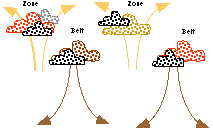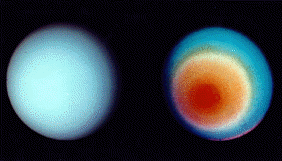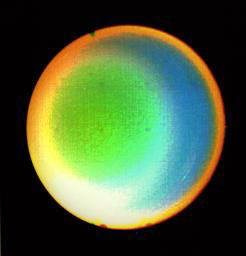This is an image of Uranus' atmosphere.
Click on image for full size
NASA
An Overview of Motions in Uranus' Atmosphere
Motions of air in the atmosphere include wind. The major winds in the Uranian atmosphere are
zonal winds, which have zones blowing west and belts flowing east.
Motion of air in the atmosphere can also happen by diffusion. There is a continual circulation within the atmosphere from the top to the bottom. Ethane moves down through the atmosphere and collects at the bottom where it breaks apart and becomes methane. The methane returns to the top of the atmosphere and is transformed into methane again. This perpetual breakdown and assembly of methane and ethane is part of the development of Uranus and affects its weather.
You might also be interested in:

On Uranus, as on Jupiter, the winds in the belts and zones blow first in one direction, then in the opposite direction. Wind blows east in a belt, and west in a zone. The clouds rise up in a belt, and
...more
The weather on earth can be described this way: air rises at the equator, where it is warm, and moves to the poles where it is colder and the air sinks. Because Uranus lies on its side, with the north
...more
Besides methane, Uranus' atmosphere contains even more complex molecules such as ethane gas. (These gases are similar to the exhaust gases that come out of cars on earth). These molecules form layers of
...more
The mesosphere of Uranus is a region of balance between warming and cooling. That essentially means that nothing happens there. Except for diffusion, the atmosphere is still. Upper reaches of the atmosphere,
...more
As on Earth, the atmosphere of Uranus consists of a troposphere, stratosphere, mesosphere, and thermosphere. The troposphere is the region where the visible clouds are to be found. The stratosphere, as
...more
The clouds on Uranus, like Jupiter, are divided into belts and zones. On Uranus the belts and zones are hard to find. The left picture shows the north pole of Uranus. In this picture only the smog of
...more
The clouds of Uranus, composed of methane crystals, are found very low in the atmosphere, and are difficult to see below the smog haze s of the planet. False color is used, in the image of Uranus to the
...more














